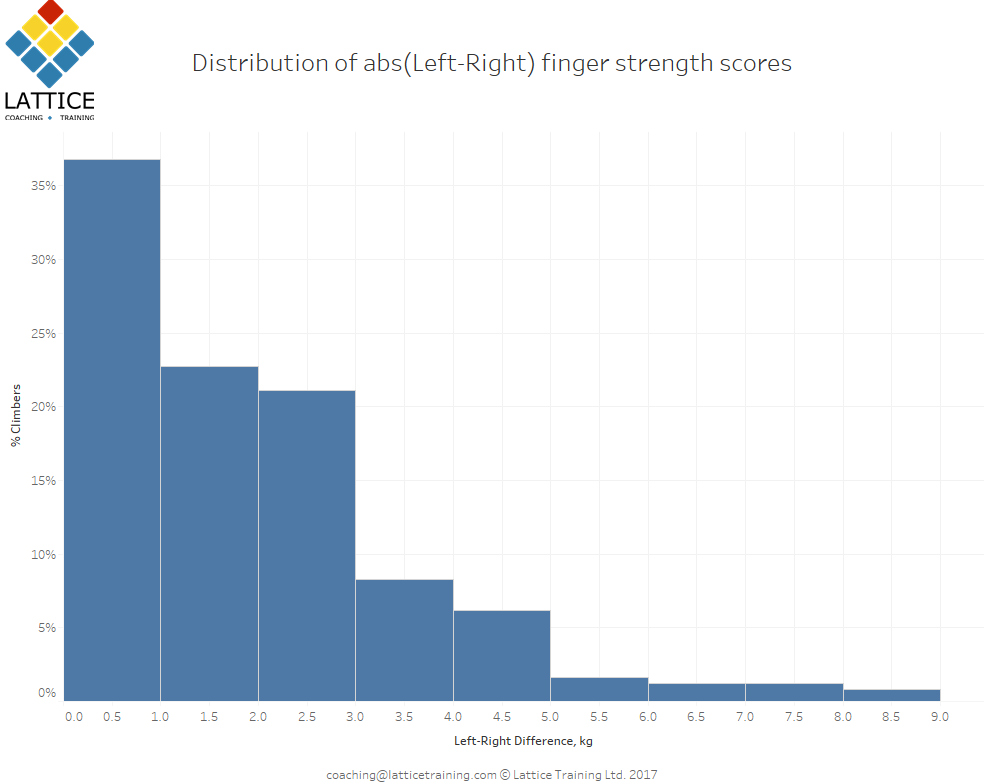Do strength imbalances make a difference in climbing? Part 1
We were thinking about left-right hand strength imbalances recently and instead of asking all the questions ourselves we thought it would be fun to put it to you, the climbers, in the form of a facebook post!
There were a lot of interesting questions (aren’t there always?!) so we’ve picked a few that were the most approachable with our current dataset. We’ll look at these questions across a series of posts. This piece being part 1.
Are there consistent left-right imbalances?
We test maximum finger strength on both the left and right hands as part of our standard Lattice Board Assessment so we can simply look for differences in this data.

We can only test finger strength with limited accuracy (from a practicality point of view we tend to test in 1kg or 0.5kg increments) so this might explain why there are a large portion of climbers in the ‘same’ category. If we assume these climbers have an equal chance of being either left or right dominant then there is a significantly larger number of climbers with the right hand stronger than the left so it’s unlikely (p<0.001) to be down to the toss of a coin.
Are there any correlation to handedness?
Unfortunately we’ve only recently started collecting data on the climbers dominant hand (i.e. whether they’re left or right handed) so we can’t look at whether there’s a relationship between dominant hand and how they score in the max strength tests. What we can do is to compare to the overall ratio of left/right handedness in the wider population. The percentage of left handed people in the general population is ~12% and we see ~39% of people with a strongest left hand in our data (assuming people in the ‘same’ category are equally likely to be stronger in the left or right hand), so it seems unlikely that handedness is the only answer in explaining why the climbers we’ve tested tend to have stronger right hands. Our suspicion is that handedness is a big factor but there are lots of other subtle external factors that come in to deciding which hand ends up coming out stronger.
We can dig a little deeper by looking at how big the differences between left and right handed finger strength scores are.


What this shows us is that on average the difference between the left and right hand is usually fairly small: ~1.6kg. Given this it’s easy to imagine environmental factors coming in to play to shift this around early on in a climbers development. On the plus side it also means that for the majority of climbers it is likely to be fairly easy to correct a left-right finger strength imbalance, though whether this is beneficial is not clear so far.
One other interesting thing we spotted when looking at the data was that there appears to be bigger differences between left and right hands when looking at Males vs. Females. This might be something interesting, though we’d need more data to say for sure.
Stay tuned for part 2!






I own a tindeq and collected data the last Months. I have a 10 kg weight diffrence between my left and right side. With the left I can hang 64 kg max and with the right 74 kg (which is my bodyweight for a few seconds). I wounder why. I dont feel a big differentes when I climb on the wall. I also do every exercise with both sides and was not injured on the left only on the right which is my strong side. Should I be worried that I hve some blockage of nervs? I feel good otherwise and have no pain.
Hi Anton! Not all nerve issues present with pain. The Roos Test can be a good way to see if there might be some nerve blockage. However, it might not be a nerve issue. It could simply be that you are stronger on one side than the other! It is pretty common for people to have a stronger side.
Slightly late reply, but just in case anybody’s still reading:
I noticed when I used to do a lot of trad (a long time ago now) that I had better endurance on the left. I’m right handed, and I suspected this was because I naturally tended if possible to fiddle with gear with my dominant hand while hanging on with the other one.
We’re always watching here at Lattice Towers 😉
That’s an interesting observation! Would be cool to see if it plays out in a broader population of trad climbers, though my guess is that there are a lot of other factors that probably come in to play. e.g. youd need to be doing trad at a high enough grade that you end up spending a significant amount of time hanging on your arms placing gear, so that could make things trickier to interpret.